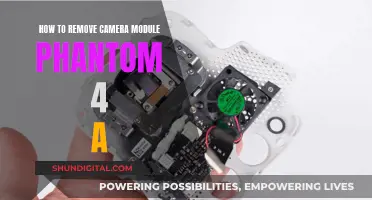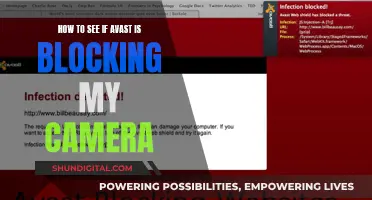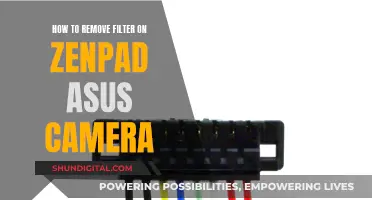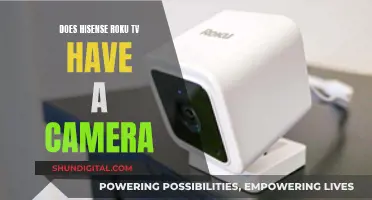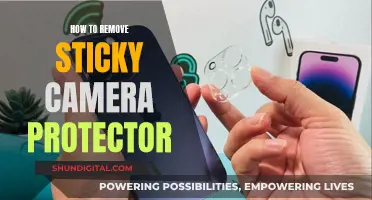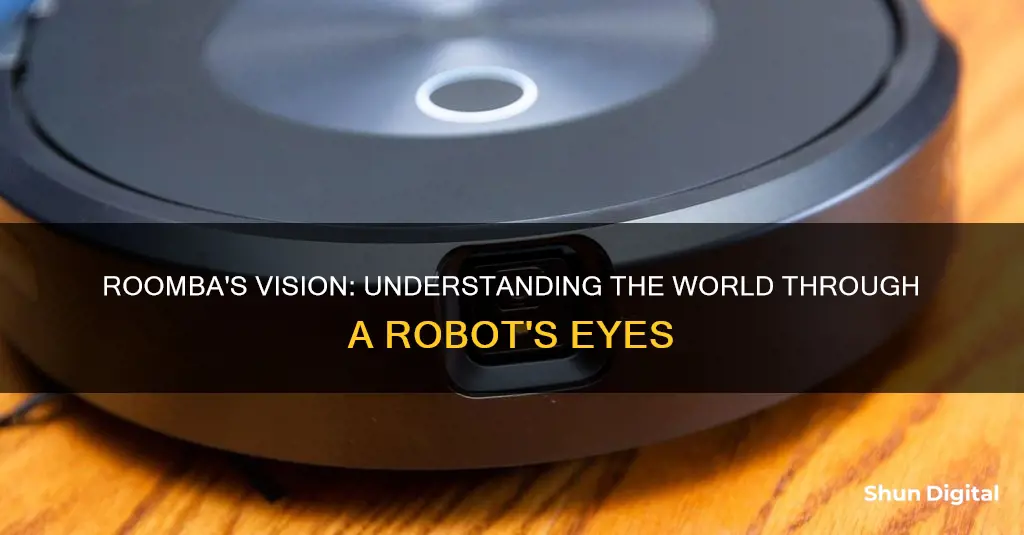
The Roomba 980 is a round robotic vacuum that uses a low-resolution camera to map your house, assessing where objects are in space and understanding the layout of the room while working. The camera is angled towards the horizon of the room and perceives its environment as a pattern of light and dark contrast points in its field of view. This allows the Roomba to avoid bumping into furniture and other objects on the floor, as well as to navigate under furniture and around clutter. While the camera does not record or store any videos, some privacy concerns have been raised about the potential for hacking and data sharing by vacuum providers.
| Characteristics | Values |
|---|---|
| Camera Usage | Mapping, Navigation, Security |
| Camera Type | Low-Resolution |
| Camera Angle | Forward and Up at 45 degrees |
| Mapping | Visual Simultaneous Localization and Mapping (VSLAM) |
| Mapping Data | Stored on Cloud, User's Mobile Device, or Robot Itself |
| Data Encryption | AES 256-bit encryption and Transport Layer Security (TLS v1.2) |
| Data Sharing | With Third Parties (Google, Amazon, IFTTT) With User Consent |
| Data Retention | Up to 30 Cleaning Jobs |
What You'll Learn

The Roomba 980 uses a low-res camera to map your house
The Roomba 980 is a round robotic vacuum that uses a low-res camera to map your house. It is iRobot's first Wi-Fi-connected robot vacuum, and it can be controlled via the iRobot Home mobile app available for Android and iOS devices. The app allows you to schedule cleaning times, set cleaning preferences, and customise cleaning methods.
The Roomba 980 uses visual simultaneous localisation and mapping (vSLAM) to navigate and clean larger spaces in straight lines. It can cover an entire level of a home with multiple rooms, recharging as needed until the job is done. The low-res camera, along with tracking sensors, helps the Roomba 980 to map out the floor plan of your home, including the placement of furniture and other objects in the space. This allows the robot to avoid obstacles and clean more efficiently.
While the camera does not record or store any videos, it is used to assess the distance travelled inside a home and to create a map of the cleaning area. The Roomba 980 uses the camera to identify "landmarks" such as a chair or a coffee table, recognising and memorising their shapes. This information, combined with data from tracking sensors, enables the Roomba 980 to map out every space it touches within your home.
The Roomba 980 also has a feature called Carpet Boost, which prompts the robot to clean with more power when it senses that it is moving over a carpet instead of a hardwood floor. This feature further enhances the efficiency of the cleaning process.
Adjusting Q-See Cameras: A Step-by-Step Guide for Beginners
You may want to see also

Roomba cameras can't record or store videos
Roomba Cameras: What They Can and Can't Do
The iRobot Roomba is a popular robotic vacuum cleaner that has been on the market for over two decades. In recent years, iRobot has introduced new features, including cameras, which have raised questions and concerns about privacy and security. This article will explore the capabilities and limitations of Roomba cameras, specifically addressing whether they can record or store videos.
Roomba Camera Technology:
Roomba cameras use computer vision, a type of artificial intelligence that enables the device to "see" and understand its surroundings. This technology allows the Roomba to identify and avoid obstacles, such as furniture and other objects on the floor, improving its navigation and cleaning abilities. The camera also helps the Roomba create a map of the user's home, making it more efficient at cleaning.
Privacy and Security Concerns:
The presence of cameras in robotic vacuum cleaners has sparked concerns among consumers about potential privacy invasions. While Roomba cameras can capture images and videos of their surroundings, it's important to clarify that they do not have the capability to record or store videos directly. iRobot, the company behind Roomba, has stated that their vacuum cleaners are designed with privacy and security in mind.
No Recording or Storing of Videos:
Roomba cameras cannot record or store videos on the device itself. The camera is primarily used for navigation and mapping purposes, and any images or videos captured are not saved for an extended period. iRobot also assures users that they do not share any images or videos with third parties, addressing concerns about data sharing. This commitment to privacy is essential for maintaining trust with their customers.
Data Collection for AI Training:
While Roomba cameras don't record or store videos, it's important to understand that iRobot does collect data for the purpose of training its artificial intelligence algorithms. This data collection involves users who have consented to participate in product improvement initiatives. iRobot obtains images and videos from volunteers, including some of its employees, who know that their data is being used for computer vision research. This data is crucial for teaching the Roomba to recognize various objects and improve its performance over time.
In conclusion, while Roomba cameras have the capability to capture images and videos for navigation and mapping, they do not record or store videos directly on the device. iRobot prioritizes privacy and security, ensuring that any data collected is handled securely and not shared with third parties. As robotic vacuum technology continues to evolve, it's essential to stay informed about the capabilities and limitations of these devices to make informed decisions as a consumer.
Finding Your Camera on Skype 10: A Quick Guide
You may want to see also

Roomba doesn't share images or videos with third parties
The iRobot Roomba is a round robotic vacuum that uses a low-resolution camera to map your house, working out where objects are in space and understanding the layout of the room while working. The camera is angled towards the horizon of the room and does not record or store any videos or images for the safety and privacy of the user.
The Roomba uses visual simultaneous localization and mapping (vSLAM) to keep track of its location until it has cleaned an entire level. This means it knows which spots it has missed and will work tirelessly for two hours, recharge, and then head back into the fray until it is done. The camera is used to assess the distance travelled inside a home and does not identify objects in the house. The camera perceives its environment as a pattern of light and dark contrast points in its field of view. It uses these contrast points to localize its position on its map, enabling the robot to efficiently navigate and clean an entire level of a home.
The Roomba does not take video or transmit any images to the cloud. If a user agrees to having their map data viewable on their mobile device, then the map that the Roomba creates during a cleaning job is sent to the cloud. The data is encrypted both in transit and at rest. Data access is controlled strictly and limited only to authorized iRobot customer service personnel. iRobot does not share images or videos with third parties.
Unlocking the Messenger Camera's Magical Effects
You may want to see also

Roomba's camera is angled towards the horizon of a room
The Roomba 980 is a round robotic vacuum that uses a low-resolution camera to map your house. This camera is angled towards the horizon of a room. It assesses where objects are in space and understands the layout of the room while working. The Roomba uses visual simultaneous localization and mapping (vSLAM) to keep track of its location until it has cleaned an entire level. This means the Roomba knows which spots it missed and will work tirelessly for two hours, recharge, and then head back into the fray until it is done.
The camera perceives its environment as a pattern of light and dark contrast points in its field of view. It uses these contrast points to localize its position on its map, enabling the robot to efficiently navigate and clean an entire level of a home. The Roomba does not take video or transmit any images to the cloud. Instead, it uses its camera to map furniture to triangulate its position in your home, making it smarter at navigating than most vacs.
The Roomba 980 is the first Roomba that connects to the Internet via Wi-Fi, allowing you to command it with a smartphone. It also has enhanced virtual walls that can provide area denial capability to keep the robot from running into pet food and water dishes and other things that you keep on the floor but don't want to be tackled by a robot. The camera on the Roomba 980 is pointed forward and up at what looks to be about 45 degrees. This allows the robot to dynamically build a map while keeping track of its position at the same time.
The Roomba 980 is a big deal for iRobot, as it packs a lot of new technology into one robot vacuum. It is the first Roomba that connects to the internet via Wi-Fi and has a camera for mapping and navigation. While the camera on the Roomba 980 has many benefits, there are some privacy concerns that users should be aware of. iRobot has taken measures to adhere to strict privacy compliance standards and has implemented a sophisticated approach to encrypting data.
Watching King Doway Camera Feeds on PC
You may want to see also

The Roomba 980 can be controlled via a smartphone app
The Roomba 980 is a round robotic vacuum that uses a low-res video camera to map your house, assessing where objects are in space and understanding the layout of the room while working. It uses something called visual simultaneous localisation and mapping (vSLAM) to keep track of its location until it has cleaned an entire level. This means the Roomba knows which spots it missed and will work tirelessly for two hours, recharge, and then head back into the fray until it is done.
The Roomba 980 uses advanced software along with optical and audio sensors to thoroughly clean rooms from edge to edge, detecting areas that require concentrated cleaning while avoiding furniture and stairs. It is ideal for pet owners and allergy sufferers, as it forgoes typical vacuum brushes for two rubber rollers that break down debris while a powerful vacuum deposits dirt, dust, hair, and allergens into a HEPA-filtered bin. The Roomba 980 runs continuously for up to two hours and automatically recharges itself and resumes cleaning until the job is complete.
Hooking Up Your Camera: Displaying Photos on Your TV Screen
You may want to see also
Frequently asked questions
Yes, the Roomba 980 model is equipped with a low-resolution camera that helps it to map out the user's home and navigate its way around furniture and other objects on the floor.
The Roomba camera uses visual simultaneous localization and mapping (vSLAM) to keep track of its location and create a map of the user's home. It takes pictures and looks for distinctive patterns of pixels to create a map and navigate.
The Roomba camera sees its environment as a pattern of light and dark contrast points. It does not take video or transmit any images to the cloud, and it does not identify specific objects like sofas or beds.
Any device connected to the internet can potentially be hacked, including the Roomba. However, iRobot states that they have taken measures to protect user data and privacy, and that data is encrypted both in transit and at rest.
It is not clear if the camera can be turned off, but the Roomba can work without being connected to the internet, which may reduce data privacy concerns.


